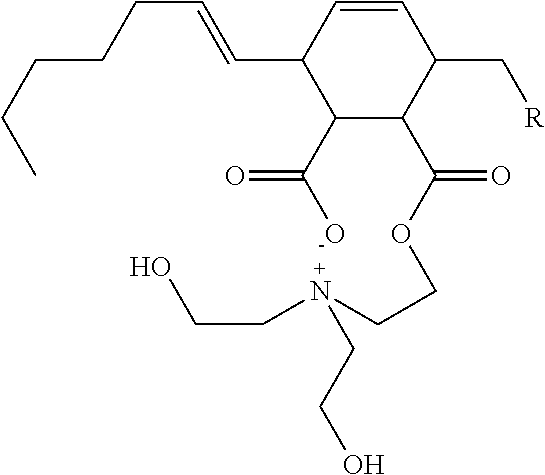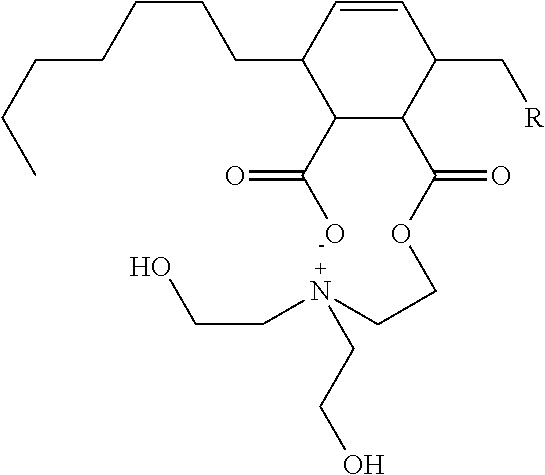Bio-based dispersants
a technology of bio-based dispersants and dispersants, applied in the field of dispersants, can solve the problems of not being able to build in most cases, requiring high mechanical forces for liquid introduction of solids, and unable to achieve the effect of physical and chemical properties
- Summary
- Abstract
- Description
- Claims
- Application Information
AI Technical Summary
Benefits of technology
Problems solved by technology
Method used
Image
Examples
examples
[0088]The following examples are intended to demonstrate the usefulness of preferred embodiments of the present invention and should not be considered to limit its scope or applicability in any way.
examples 1-7
[0089]The following general method was used to prepare the dispersants listed in Table 1. In a first step, 2000 g of the natural oil and either one or two molar equivalents (based on the soybean oil) of maleic anhydride were charged to a 3 L four-neck round-bottom flask. These amounts correspond to 11.0 and 22.0 weight percent of maleic anhydride based on the weight of the soybean oil respectively. Higher or lower molar ratios of maleic anhydride may be used in order to adjust water or oil solubility of the dispersant. The contents of the flask were gradually heated to 210° C. with agitation under a nitrogen sparge. The reaction mixture was held at this temperature until no free maleic anhydride was detected in the reaction mixture by GC analysis. The reaction mixture was cooled to 60° C. and triethanolamine or an alkoxylated triethanolamine at the desired molar ratio to anhydride functionality was slowly added. The reaction mixture was held at 80° C. for 1 hour or until no unreacte...
example 8
Clay Dispersions
[0090]A dispersant as prepared in Example 1 was utilized as a dispersant for the preparation of stable dispersions of bentonite clay in soybean oil which are utilized as fillers in heat set inks. A soy based alkyd resin, commonly used in the industry was used as a control or comparative example. As shown in FIG. 1, clay loadings of up to 75 percent were achieved with a soybean oil gel of Example 23 while loadings of only 50 percent were achieved with the standard soy based alkyd resin.
PUM
| Property | Measurement | Unit |
|---|---|---|
| Fraction | aaaaa | aaaaa |
| Dispersion potential | aaaaa | aaaaa |
| Thermoplasticity | aaaaa | aaaaa |
Abstract
Description
Claims
Application Information
 Login to View More
Login to View More - R&D
- Intellectual Property
- Life Sciences
- Materials
- Tech Scout
- Unparalleled Data Quality
- Higher Quality Content
- 60% Fewer Hallucinations
Browse by: Latest US Patents, China's latest patents, Technical Efficacy Thesaurus, Application Domain, Technology Topic, Popular Technical Reports.
© 2025 PatSnap. All rights reserved.Legal|Privacy policy|Modern Slavery Act Transparency Statement|Sitemap|About US| Contact US: help@patsnap.com



